MA1-745
antibody from Invitrogen Antibodies
Targeting: SNTB2
D16S2531E, EST25263, SNT2B2, SNT3, SNTL
Antibody data
- Antibody Data
- Antigen structure
- References [31]
- Comments [0]
- Validations
- Western blot [3]
- Immunocytochemistry [8]
- Other assay [13]
Submit
Validation data
Reference
Comment
Report error
- Product number
- MA1-745 - Provider product page

- Provider
- Invitrogen Antibodies
- Product name
- SNTB2 Monoclonal Antibody (1351)
- Antibody type
- Monoclonal
- Antigen
- Purifed from natural sources
- Description
- MA1-745 detects alpha 1, beta 1 and beta 2 subunits of syntrophin. This antibody has been shown to react with human, mouse, rat, chicken, canine and amphibian samples. MA1-745 has been successfully used in Western blot, immunoprecipitation and immunofluorescence procedures. By Western blot, this antibody detects an ~58 kDa protein representing syntrophin from rat and mouse cell extracts. The MA1-745 immunogen is whole purified syntrophin from Torpedo californica electric organ postsynaptic membrane. Characterization studies of this antibody have demonstrated that clone 1351 is directed against an epitope within the PDZ domain of syntrophin. MA1-745, clone 1351, is seen as the "gold standard" for syntrophin assessment.
- Reactivity
- Human, Mouse, Rat, Canine, Chicken/Avian
- Host
- Mouse
- Isotype
- IgG
- Antibody clone number
- 1351
- Vial size
- 100 μg
- Concentration
- 1 mg/mL
- Storage
- -20°C, Avoid Freeze/Thaw Cycles
Submitted references Metronomic 5-Fluorouracil Delivery Primes Skeletal Muscle for Myopathy but Does Not Cause Cachexia.
β1 Syntrophin Supports Autophagy Initiation and Protects against Cerulein-Induced Acute Pancreatitis.
Gain-of-function defects of astrocytic Kir4.1 channels in children with autism spectrum disorders and epilepsy.
Neuronal nitric oxide synthase localizes to utrophin expressing intercalated discs and stabilizes their structural integrity.
Genetically induced dysfunctions of Kir2.1 channels: implications for short QT3 syndrome and autism-epilepsy phenotype.
PDZ domain-binding motif regulates cardiomyocyte compartment-specific NaV1.5 channel expression and function.
Human T-cell leukemia virus type 1 Tax protein interacts with and mislocalizes the PDZ domain protein MAGI-1.
Phosphorylation on threonine 11 of β-dystrobrevin alters its interaction with kinesin heavy chain.
Absence of glial α-dystrobrevin causes abnormalities of the blood-brain barrier and progressive brain edema.
Differential requirement for utrophin in the induced pluripotent stem cell correction of muscle versus fat in muscular dystrophy mice.
A high throughput screen identifies chemical modulators of the laminin-induced clustering of dystroglycan and aquaporin-4 in primary astrocytes.
Knockdown of MLC1 in primary astrocytes causes cell vacuolation: a MLC disease cell model.
The beta1 subunit of the Na,K-ATPase pump interacts with megalencephalic leucoencephalopathy with subcortical cysts protein 1 (MLC1) in brain astrocytes: new insights into MLC pathogenesis.
Regulation of Kir4.1 and AQP4 expression and stability at the basolateral domain of epithelial MDCK cells by the extracellular matrix.
Synaptic localization of neuroligin 2 in the rodent retina: comparative study with the dystroglycan-containing complex.
MLC1 trafficking and membrane expression in astrocytes: role of caveolin-1 and phosphorylation.
Dystrophin-associated protein scaffolding in brain requires alpha-dystrobrevin.
The 8th and 9th tandem spectrin-like repeats of utrophin cooperatively form a functional unit to interact with polarity-regulating kinase PAR-1b.
Blastocyst injection of wild type embryonic stem cells induces global corrections in mdx mice.
TAPP2 links phosphoinositide 3-kinase signaling to B-cell adhesion through interaction with the cytoskeletal protein utrophin: expression of a novel cell adhesion-promoting complex in B-cell leukemia.
Syntrophins regulate alpha1D-adrenergic receptors through a PDZ domain-mediated interaction.
Cardiac sodium channel Nav1.5 is regulated by a multiprotein complex composed of syntrophins and dystrophin.
Purification of ATP-binding cassette transporter A1 and associated binding proteins reveals the importance of beta1-syntrophin in cholesterol efflux.
Dephosphorylation of beta2-syntrophin and Ca2+/mu-calpain-mediated cleavage of ICA512 upon stimulation of insulin secretion.
The receptor tyrosine phosphatase-like protein ICA512 binds the PDZ domains of beta2-syntrophin and nNOS in pancreatic beta-cells.
Absence of alpha-syntrophin leads to structurally aberrant neuromuscular synapses deficient in utrophin.
Absence of alpha-syntrophin leads to structurally aberrant neuromuscular synapses deficient in utrophin.
A role of tyrosine phosphatase in acetylcholine receptor cluster dispersal and formation.
Interaction of muscle and brain sodium channels with multiple members of the syntrophin family of dystrophin-associated proteins.
Differential association of syntrophin pairs with the dystrophin complex.
A postsynaptic Mr 58,000 (58K) protein concentrated at acetylcholine receptor-rich sites in Torpedo electroplaques and skeletal muscle.
Campelj DG, Timpani CA, Cree T, Petersen AC, Hayes A, Goodman CA, Rybalka E
Pharmaceuticals (Basel, Switzerland) 2021 May 17;14(5)
Pharmaceuticals (Basel, Switzerland) 2021 May 17;14(5)
β1 Syntrophin Supports Autophagy Initiation and Protects against Cerulein-Induced Acute Pancreatitis.
Ye R, Onodera T, Blanchard PG, Kusminski CM, Esser V, Brekken RA, Scherer PE
The American journal of pathology 2019 Apr;189(4):813-825
The American journal of pathology 2019 Apr;189(4):813-825
Gain-of-function defects of astrocytic Kir4.1 channels in children with autism spectrum disorders and epilepsy.
Sicca F, Ambrosini E, Marchese M, Sforna L, Servettini I, Valvo G, Brignone MS, Lanciotti A, Moro F, Grottesi A, Catacuzzeno L, Baldini S, Hasan S, D'Adamo MC, Franciolini F, Molinari P, Santorelli FM, Pessia M
Scientific reports 2016 Sep 28;6:34325
Scientific reports 2016 Sep 28;6:34325
Neuronal nitric oxide synthase localizes to utrophin expressing intercalated discs and stabilizes their structural integrity.
Gonzalez JP, Crassous PA, Schneider JS, Beuve A, Fraidenraich D
Neuromuscular disorders : NMD 2015 Dec;25(12):964-76
Neuromuscular disorders : NMD 2015 Dec;25(12):964-76
Genetically induced dysfunctions of Kir2.1 channels: implications for short QT3 syndrome and autism-epilepsy phenotype.
Ambrosini E, Sicca F, Brignone MS, D'Adamo MC, Napolitano C, Servettini I, Moro F, Ruan Y, Guglielmi L, Pieroni S, Servillo G, Lanciotti A, Valvo G, Catacuzzeno L, Franciolini F, Molinari P, Marchese M, Grottesi A, Guerrini R, Santorelli FM, Priori S, Pessia M
Human molecular genetics 2014 Sep 15;23(18):4875-86
Human molecular genetics 2014 Sep 15;23(18):4875-86
PDZ domain-binding motif regulates cardiomyocyte compartment-specific NaV1.5 channel expression and function.
Shy D, Gillet L, Ogrodnik J, Albesa M, Verkerk AO, Wolswinkel R, Rougier JS, Barc J, Essers MC, Syam N, Marsman RF, van Mil AM, Rotman S, Redon R, Bezzina CR, Remme CA, Abriel H
Circulation 2014 Jul 8;130(2):147-60
Circulation 2014 Jul 8;130(2):147-60
Human T-cell leukemia virus type 1 Tax protein interacts with and mislocalizes the PDZ domain protein MAGI-1.
Makokha GN, Takahashi M, Higuchi M, Saito S, Tanaka Y, Fujii M
Cancer science 2013 Mar;104(3):313-20
Cancer science 2013 Mar;104(3):313-20
Phosphorylation on threonine 11 of β-dystrobrevin alters its interaction with kinesin heavy chain.
Fratini F, Macchia G, Torreri P, Matteucci A, Salzano AM, Crescenzi M, Macioce P, Petrucci TC, Ceccarini M
The FEBS journal 2012 Nov;279(22):4131-44
The FEBS journal 2012 Nov;279(22):4131-44
Absence of glial α-dystrobrevin causes abnormalities of the blood-brain barrier and progressive brain edema.
Lien CF, Mohanta SK, Frontczak-Baniewicz M, Swinny JD, Zablocka B, Górecki DC
The Journal of biological chemistry 2012 Nov 30;287(49):41374-85
The Journal of biological chemistry 2012 Nov 30;287(49):41374-85
Differential requirement for utrophin in the induced pluripotent stem cell correction of muscle versus fat in muscular dystrophy mice.
Beck AJ, Vitale JM, Zhao Q, Schneider JS, Chang C, Altaf A, Michaels J, Bhaumik M, Grange R, Fraidenraich D
PloS one 2011;6(5):e20065
PloS one 2011;6(5):e20065
A high throughput screen identifies chemical modulators of the laminin-induced clustering of dystroglycan and aquaporin-4 in primary astrocytes.
Noël G, Stevenson S, Moukhles H
PloS one 2011 Mar 7;6(3):e17559
PloS one 2011 Mar 7;6(3):e17559
Knockdown of MLC1 in primary astrocytes causes cell vacuolation: a MLC disease cell model.
Duarri A, Lopez de Heredia M, Capdevila-Nortes X, Ridder MC, Montolio M, López-Hernández T, Boor I, Lien CF, Hagemann T, Messing A, Gorecki DC, Scheper GC, Martínez A, Nunes V, van der Knaap MS, Estévez R
Neurobiology of disease 2011 Jul;43(1):228-38
Neurobiology of disease 2011 Jul;43(1):228-38
The beta1 subunit of the Na,K-ATPase pump interacts with megalencephalic leucoencephalopathy with subcortical cysts protein 1 (MLC1) in brain astrocytes: new insights into MLC pathogenesis.
Brignone MS, Lanciotti A, Macioce P, Macchia G, Gaetani M, Aloisi F, Petrucci TC, Ambrosini E
Human molecular genetics 2011 Jan 1;20(1):90-103
Human molecular genetics 2011 Jan 1;20(1):90-103
Regulation of Kir4.1 and AQP4 expression and stability at the basolateral domain of epithelial MDCK cells by the extracellular matrix.
Tham DK, Moukhles H
American journal of physiology. Renal physiology 2011 Aug;301(2):F396-409
American journal of physiology. Renal physiology 2011 Aug;301(2):F396-409
Synaptic localization of neuroligin 2 in the rodent retina: comparative study with the dystroglycan-containing complex.
Lui L, Levinson JN, Noël G, Handrigan GR, Richman JM, El-Husseini A, Moukhles H
Journal of neuroscience research 2010 Mar;88(4):837-49
Journal of neuroscience research 2010 Mar;88(4):837-49
MLC1 trafficking and membrane expression in astrocytes: role of caveolin-1 and phosphorylation.
Lanciotti A, Brignone MS, Camerini S, Serafini B, Macchia G, Raggi C, Molinari P, Crescenzi M, Musumeci M, Sargiacomo M, Aloisi F, Petrucci TC, Ambrosini E
Neurobiology of disease 2010 Mar;37(3):581-95
Neurobiology of disease 2010 Mar;37(3):581-95
Dystrophin-associated protein scaffolding in brain requires alpha-dystrobrevin.
Bragg AD, Das SS, Froehner SC
Neuroreport 2010 Jul 14;21(10):695-9
Neuroreport 2010 Jul 14;21(10):695-9
The 8th and 9th tandem spectrin-like repeats of utrophin cooperatively form a functional unit to interact with polarity-regulating kinase PAR-1b.
Yamashita K, Suzuki A, Satoh Y, Ide M, Amano Y, Masuda-Hirata M, Hayashi YK, Hamada K, Ogata K, Ohno S
Biochemical and biophysical research communications 2010 Jan 1;391(1):812-7
Biochemical and biophysical research communications 2010 Jan 1;391(1):812-7
Blastocyst injection of wild type embryonic stem cells induces global corrections in mdx mice.
Stillwell E, Vitale J, Zhao Q, Beck A, Schneider J, Khadim F, Elson G, Altaf A, Yehia G, Dong JH, Liu J, Mark W, Bhaumik M, Grange R, Fraidenraich D
PloS one 2009;4(3):e4759
PloS one 2009;4(3):e4759
TAPP2 links phosphoinositide 3-kinase signaling to B-cell adhesion through interaction with the cytoskeletal protein utrophin: expression of a novel cell adhesion-promoting complex in B-cell leukemia.
Costantini JL, Cheung SM, Hou S, Li H, Kung SK, Johnston JB, Wilkins JA, Gibson SB, Marshall AJ
Blood 2009 Nov 19;114(21):4703-12
Blood 2009 Nov 19;114(21):4703-12
Syntrophins regulate alpha1D-adrenergic receptors through a PDZ domain-mediated interaction.
Chen Z, Hague C, Hall RA, Minneman KP
The Journal of biological chemistry 2006 May 5;281(18):12414-20
The Journal of biological chemistry 2006 May 5;281(18):12414-20
Cardiac sodium channel Nav1.5 is regulated by a multiprotein complex composed of syntrophins and dystrophin.
Gavillet B, Rougier JS, Domenighetti AA, Behar R, Boixel C, Ruchat P, Lehr HA, Pedrazzini T, Abriel H
Circulation research 2006 Aug 18;99(4):407-14
Circulation research 2006 Aug 18;99(4):407-14
Purification of ATP-binding cassette transporter A1 and associated binding proteins reveals the importance of beta1-syntrophin in cholesterol efflux.
Okuhira K, Fitzgerald ML, Sarracino DA, Manning JJ, Bell SA, Goss JL, Freeman MW
The Journal of biological chemistry 2005 Nov 25;280(47):39653-64
The Journal of biological chemistry 2005 Nov 25;280(47):39653-64
Dephosphorylation of beta2-syntrophin and Ca2+/mu-calpain-mediated cleavage of ICA512 upon stimulation of insulin secretion.
Ort T, Voronov S, Guo J, Zawalich K, Froehner SC, Zawalich W, Solimena M
The EMBO journal 2001 Aug 1;20(15):4013-23
The EMBO journal 2001 Aug 1;20(15):4013-23
The receptor tyrosine phosphatase-like protein ICA512 binds the PDZ domains of beta2-syntrophin and nNOS in pancreatic beta-cells.
Ort T, Maksimova E, Dirkx R, Kachinsky AM, Berghs S, Froehner SC, Solimena M
European journal of cell biology 2000 Sep;79(9):621-30
European journal of cell biology 2000 Sep;79(9):621-30
Absence of alpha-syntrophin leads to structurally aberrant neuromuscular synapses deficient in utrophin.
Adams ME, Kramarcy N, Krall SP, Rossi SG, Rotundo RL, Sealock R, Froehner SC
The Journal of cell biology 2000 Sep 18;150(6):1385-98
The Journal of cell biology 2000 Sep 18;150(6):1385-98
Absence of alpha-syntrophin leads to structurally aberrant neuromuscular synapses deficient in utrophin.
Adams ME, Kramarcy N, Krall SP, Rossi SG, Rotundo RL, Sealock R, Froehner SC
The Journal of cell biology 2000 Sep 18;150(6):1385-98
The Journal of cell biology 2000 Sep 18;150(6):1385-98
A role of tyrosine phosphatase in acetylcholine receptor cluster dispersal and formation.
Dai Z, Peng HB
The Journal of cell biology 1998 Jun 29;141(7):1613-24
The Journal of cell biology 1998 Jun 29;141(7):1613-24
Interaction of muscle and brain sodium channels with multiple members of the syntrophin family of dystrophin-associated proteins.
Gee SH, Madhavan R, Levinson SR, Caldwell JH, Sealock R, Froehner SC
The Journal of neuroscience : the official journal of the Society for Neuroscience 1998 Jan 1;18(1):128-37
The Journal of neuroscience : the official journal of the Society for Neuroscience 1998 Jan 1;18(1):128-37
Differential association of syntrophin pairs with the dystrophin complex.
Peters MF, Adams ME, Froehner SC
The Journal of cell biology 1997 Jul 14;138(1):81-93
The Journal of cell biology 1997 Jul 14;138(1):81-93
A postsynaptic Mr 58,000 (58K) protein concentrated at acetylcholine receptor-rich sites in Torpedo electroplaques and skeletal muscle.
Froehner SC, Murnane AA, Tobler M, Peng HB, Sealock R
The Journal of cell biology 1987 Jun;104(6):1633-46
The Journal of cell biology 1987 Jun;104(6):1633-46
No comments: Submit comment
Supportive validation
- Submitted by
- Invitrogen Antibodies (provider)
- Main image
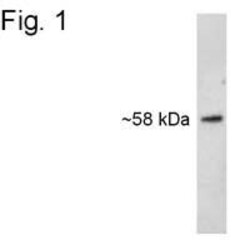
- Experimental details
- Western blot analysis of Syntrophin was performed using Syntrophin Monoclonal Antibody (Product # MA1-745) on canine lysate.
- Submitted by
- Invitrogen Antibodies (provider)
- Main image
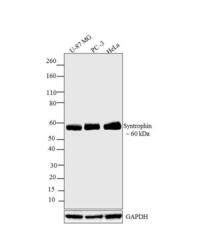
- Experimental details
- Western blot analysis was performed on whole cell extracts (30 µg lysate) of U-87MG (Lane 1), PC 3 (Lane 2) and HeLa (Lane 3). The blots were probed with Anti-Syntrophin Mouse Monoclonal Antibody (Product # MA1-745, 0.1-1 µg/mL) and detected by chemiluminescence Goat anti-Mouse IgG (H+L) Secondary Antibody, HRP conjugate (Product # 62-6520, 1:4000 dilution). A 60 kDa band corresponding to Syntrophin was observed across cell lines tested. Known quantity of protein samples were electrophoresed using Novex® NuPAGE®12 % Bis-Tris gel (Product # NP0342BOX), XCell SureLock™ Electrophoresis System (Product # EI0002) and Novex® Sharp Pre-Stained Protein Standard (Product # LC5800). Resolved proteins were then transferred onto a nitrocellulose membrane by iBlot® 2 Dry Blotting System (Product # IB21001).The membrane was probed with the relevant primary and secondary Antibody following blocking with 5 % skimmed milk. Chemiluminescent detection was performed using Pierce™ ECL Western Blotting Substrate (Product # 32106).
- Submitted by
- Invitrogen Antibodies (provider)
- Main image
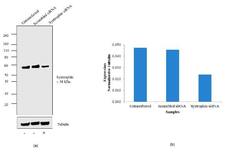
- Experimental details
- Knockdown of Syntrophin was achieved by transfecting U87MG with Syntrophin specific siRNA (Silencer® select Product # s13261 and s13263). Western blot analysis was performed using whole cell lysates from the Syntrophin knock down cells (lane 3), non-specific scrambled siRNA transfected cells (lane 2) and untransfected cells (lane 1). The blots were probed with Anti-Syntrophin Mouse Monoclonal Antibody (Product # MA1-745, 0.1-1 µg/mL) and Goat anti-Mouse IgG (H+L) Secondary Antibody, HRP conjugate (Product # 62-6520, 1:4000 dilution). Loss of signal upon siRNA mediated knock down confirms that antibody is specific to Syntrophin.
Supportive validation
- Submitted by
- Invitrogen Antibodies (provider)
- Main image
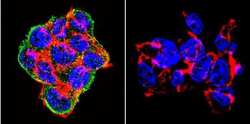
- Experimental details
- Immunofluorescent analysis of Syntrophin using Syntrophin Monoclonal Antibody (1351) (Product # MA1-745) shows staining in 293Cells. Syntrophin (green), F-Actin staining with Phalloidin (red) and nuclei with DAPI (blue) is shown. Cells were grown on chamber slides and fixed with formaldehyde prior to staining. Cells were probed without (control) or with an antibody recognizing Syntrophin (Product # MA1-745) at a dilution of 1:20 over night at 4 °C, washed with PBS and incubated with a DyLight-488 conjugated secondary antibody (Product # 35552 for GAR, Product # 35503 for GAM). Images were taken at 60X magnification.
- Submitted by
- Invitrogen Antibodies (provider)
- Main image
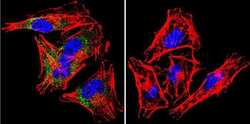
- Experimental details
- Immunofluorescent analysis of Syntrophin using Syntrophin Monoclonal Antibody (1351) (Product # MA1-745) shows staining in A2058 Cells. Syntrophin (green), F-Actin staining with Phalloidin (red) and nuclei with DAPI (blue) is shown. Cells were grown on chamber slides and fixed with formaldehyde prior to staining. Cells were probed without (control) or with an antibody recognizing Syntrophin (Product # MA1-745) at a dilution of 1:20 over night at 4 °C, washed with PBS and incubated with a DyLight-488 conjugated secondary antibody (Product # 35552 for GAR, Product # 35503 for GAM). Images were taken at 60X magnification.
- Submitted by
- Invitrogen Antibodies (provider)
- Main image
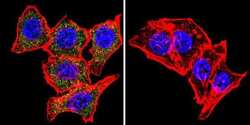
- Experimental details
- Immunofluorescent analysis of Syntrophin using Syntrophin Monoclonal Antibody (1351) (Product # MA1-745) shows staining in Hela Cells. Syntrophin (green), F-Actin staining with Phalloidin (red) and nuclei with DAPI (blue) is shown. Cells were grown on chamber slides and fixed with formaldehyde prior to staining. Cells were probed without (control) or with an antibody recognizing Syntrophin (Product # MA1-745) at a dilution of 1:20 over night at 4 °C, washed with PBS and incubated with a DyLight-488 conjugated secondary antibody (Product # 35552 for GAR, Product # 35503 for GAM). Images were taken at 60X magnification.
- Submitted by
- Invitrogen Antibodies (provider)
- Main image
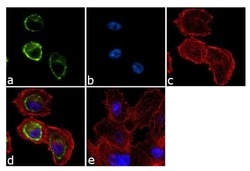
- Experimental details
- Immunofluorescence analysis of Syntrophin was done on 70% confluent log phase PC-3 cells. The cells were fixed with 4% paraformaldehyde for 10 minutes, permeabilized with 0.1% Triton™ X-100 for 10 minutes, and blocked with 1% BSA for 1 hour at room temperature. The cells were labeled with Syntrophin (1351) Mouse Monoclonal Antibody (Product # MA1-745) at 2 µg/mL in 0.1% BSA and incubated for 3 hours at room temperature and then labeled with Goat anti-Mouse IgG (H+L) Superclonal™ Secondary Antibody, Alexa Fluor® 488 conjugate (Product # A28175) at a dilution of 1:2000 for 45 minutes at room temperature (Panel a: green). Nuclei (Panel b: blue) were stained with SlowFade® Gold Antifade Mountant with DAPI (Product # S36938). F-actin (Panel c: red) was stained with Alexa Fluor® 555 Rhodamine Phalloidin (Product # R415, 1:300). Panel d is a merged image showing cytoplasmic localization. Panel e is a no primary antibody control. The images were captured at 60X magnification.
- Submitted by
- Invitrogen Antibodies (provider)
- Main image
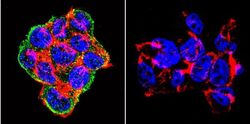
- Experimental details
- Immunofluorescent analysis of Syntrophin using Syntrophin Monoclonal Antibody (1351) (Product # MA1-745) shows staining in 293Cells. Syntrophin (green), F-Actin staining with Phalloidin (red) and nuclei with DAPI (blue) is shown. Cells were grown on chamber slides and fixed with formaldehyde prior to staining. Cells were probed without (control) or with an antibody recognizing Syntrophin (Product # MA1-745) at a dilution of 1:20 over night at 4 °C, washed with PBS and incubated with a DyLight-488 conjugated secondary antibody (Product # 35552 for GAR, Product # 35503 for GAM). Images were taken at 60X magnification.
- Submitted by
- Invitrogen Antibodies (provider)
- Main image
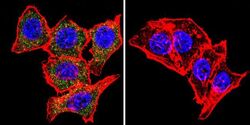
- Experimental details
- Immunofluorescent analysis of Syntrophin using Syntrophin Monoclonal Antibody (1351) (Product # MA1-745) shows staining in Hela Cells. Syntrophin (green), F-Actin staining with Phalloidin (red) and nuclei with DAPI (blue) is shown. Cells were grown on chamber slides and fixed with formaldehyde prior to staining. Cells were probed without (control) or with an antibody recognizing Syntrophin (Product # MA1-745) at a dilution of 1:20 over night at 4 °C, washed with PBS and incubated with a DyLight-488 conjugated secondary antibody (Product # 35552 for GAR, Product # 35503 for GAM). Images were taken at 60X magnification.
- Submitted by
- Invitrogen Antibodies (provider)
- Main image
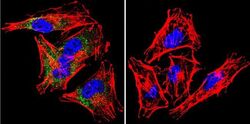
- Experimental details
- Immunofluorescent analysis of Syntrophin using Syntrophin Monoclonal Antibody (1351) (Product # MA1-745) shows staining in A2058 Cells. Syntrophin (green), F-Actin staining with Phalloidin (red) and nuclei with DAPI (blue) is shown. Cells were grown on chamber slides and fixed with formaldehyde prior to staining. Cells were probed without (control) or with an antibody recognizing Syntrophin (Product # MA1-745) at a dilution of 1:20 over night at 4 °C, washed with PBS and incubated with a DyLight-488 conjugated secondary antibody (Product # 35552 for GAR, Product # 35503 for GAM). Images were taken at 60X magnification.
- Submitted by
- Invitrogen Antibodies (provider)
- Main image
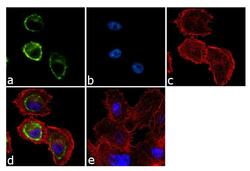
- Experimental details
- Immunofluorescence analysis of Syntrophin was done on 70% confluent log phase PC-3 cells. The cells were fixed with 4% paraformaldehyde for 10 minutes, permeabilized with 0.1% Triton™ X-100 for 10 minutes, and blocked with 1% BSA for 1 hour at room temperature. The cells were labeled with Syntrophin (1351) Mouse Monoclonal Antibody (Product # MA1-745) at 2 µg/mL in 0.1% BSA and incubated for 3 hours at room temperature and then labeled with Goat anti-Mouse IgG (H+L) Superclonal™ Secondary Antibody, Alexa Fluor® 488 conjugate (Product # A28175) at a dilution of 1:2000 for 45 minutes at room temperature (Panel a: green). Nuclei (Panel b: blue) were stained with SlowFade® Gold Antifade Mountant with DAPI (Product # S36938). F-actin (Panel c: red) was stained with Alexa Fluor® 555 Rhodamine Phalloidin (Product # R415, 1:300). Panel d is a merged image showing cytoplasmic localization. Panel e is a no primary antibody control. The images were captured at 60X magnification.
Supportive validation
- Submitted by
- Invitrogen Antibodies (provider)
- Main image
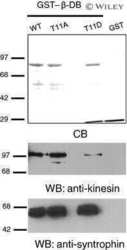
- Experimental details
- NULL
- Submitted by
- Invitrogen Antibodies (provider)
- Main image
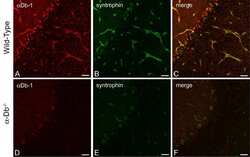
- Experimental details
- NULL
- Submitted by
- Invitrogen Antibodies (provider)
- Main image
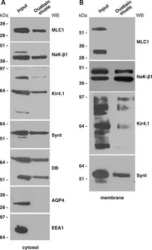
- Experimental details
- NULL
- Submitted by
- Invitrogen Antibodies (provider)
- Main image
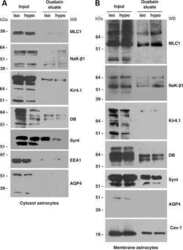
- Experimental details
- NULL
- Submitted by
- Invitrogen Antibodies (provider)
- Main image
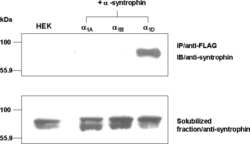
- Experimental details
- NULL
- Submitted by
- Invitrogen Antibodies (provider)
- Main image
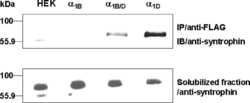
- Experimental details
- NULL
- Submitted by
- Invitrogen Antibodies (provider)
- Main image
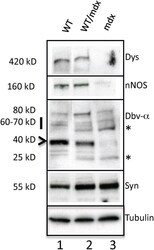
- Experimental details
- Figure 10 WT/mdx muscle displays nNOS and dystrobrevin-alpha. Protein extracts from diaphragms of WT (lane 1), 10-30% WT/mdx (lane 2) and mdx (lane 3) mice were subjected to a western blot for dystrophin, nNOS, dystrobrevin-alpha, syntrophin and tubulin. *: dystrobrevin-alpha isoforms enriched in mdx and WT/mdx but not in WT muscle. Experiments were performed with pectoralis, diaphragm and quadriceps muscles of 3 animals (n = 3) per group (WT, 10-30% WT/mdx and mdx).
- Submitted by
- Invitrogen Antibodies (provider)
- Main image
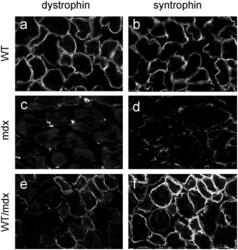
- Experimental details
- Figure 11 Syntrophin is present in WT/mdx but not in the mdx muscle. a-f, diaphragms from WT (a, b), mdx (c, d), and 10-30% WT/mdx (e-f) mice were sectioned and stained for dystrophin (a, c, e) and syntrophin (b, d, f). Magnification: 200x. Experiments were performed with diaphragms of 2 animals (n = 2) per group (WT, mdx and 10-30% WT/mdx).
- Submitted by
- Invitrogen Antibodies (provider)
- Main image
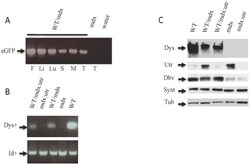
- Experimental details
- Figure 1 iPSCs incorporate globally. a) PCR analysis showing that eGFP marker (indicative of iPSCs) is present globally in the WT/mdx chimera; b) Semi Q genomic PCR using DNA from quadriceps muscle. Note that the intensity of the Dys+ band (indicative of percentage of iPSC chimerism) in WT/mdx and WT/mdx:utrophin is approximately 1/5 of that observed in WT; c) WB analysis showing dystrophin, utrophin, dystrobrevin and syntrophin production in the quadriceps. Abbreviations: eGFP: enhanced green fluorescent protein, F: fat, Li: liver, Lu: lung, S: spleen, M: quadriceps muscle, T: tail, dys+: WT allele of dystrophin, Id+: WT allele of Id1 control (Id1 is present in both iPSC-derived and blastocyst-derived cells, and thus, is invariant among WT, KO and chimeric groups), Dys: 420 Kd dystrophin, Utr: 420 Kd utrophin, Dbv: 40 Kd (isoform of the dystrophin-dependent) dystrobrevin-alpha, Synt: 55 Kd syntrophin; Tub: 55 Kd tubulin.
- Submitted by
- Invitrogen Antibodies (provider)
- Main image
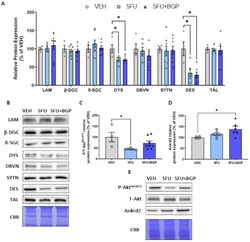
- Experimental details
- Figure 3 The effect of 5-fluorouracil (5FU) and 5FU with BGP-15 (5FU+BGP) treatment on expression of cytoskeletal structural proteins. Western blotting experiments were undertaken in tibialis anterior (TA) muscle homogenate, with samples probed for ( A , B ) cytoskeletal structural proteins including; laminin (LAM), -dystroglycan (-DGC), -sarcoglycan (-SGC), dystrophin (DYS), dystrobrevin (DBVN), syntrophin (SYTN), desmin (DES) and talin (TAL). ( C ) Phosphorylated (Ser473) and total Akt were probed for as an indicator of mammalian target of rapamycin Complex 2 (mTORC2) activity. ( D ) Ankrd2 was probed for as a marker of mechano-sensitvit. ( E ) Representative images for phosphorylated Akt Ser473 , total Akt and Ankrd2 displayed. Protein expression was normalised to total protein derived from Coomassie Brilliant Blue (CBB) staining and presented relative to vehicle (VEH) control group. * = p < 0.05; n = 4 for VEH and n = 6-8 for 5FU and 5FU+BGP groups for Western blotting. Data are mean +- SEM.
- Submitted by
- Invitrogen Antibodies (provider)
- Main image
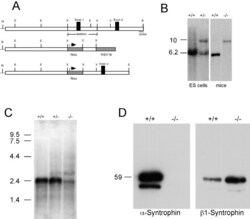
- Experimental details
- Figure 1 Generation and characterization of alpha-syntrophin mice. A, A targeting vector was constructed using a 7.4-kb Not I (N)/XbaI (X) restriction fragment long arm and a 1.5-kb XbaI fragment short arm. Homologous recombination resulted in the deletion of 2.8-kb of the alpha-syntrophin gene including all of exon 1. B, Southern blot analysis was performed using genomic DNA (isolated from ES cells or from mice) digested with EcoRI (E). Hybridization using the 500-bp probe shown in A, detected a 6.2-kb wild-type band and a 10-kb recombinant band. C, RNA blot analysis of poly A + RNA from the mice indicated. The positions of RNA standards are indicated. D, Immunoblot of muscle proteins partially purified with mAb 1351 and detected with alpha-syntrophin and beta1-syntrophin isoform specific antibodies. The position of a 59-kD protein standard is indicated on the left.
- Submitted by
- Invitrogen Antibodies (provider)
- Main image
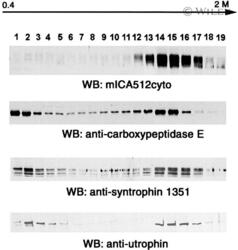
- Experimental details
- Subcellular distribution of syntrophin and utrophin in INS-1 cells. Post-nuclear supernatants of INS-1 cells were fractionated on continuous sucrose density gradients (0.4-2 M). Aliquots of each gradient fraction were immunoblotted with antibodies directed against ICA512 (mICA512cyto), carboxypeptidase E, syntrophin (1351) and utrophin.
- Submitted by
- Invitrogen Antibodies (provider)
- Main image
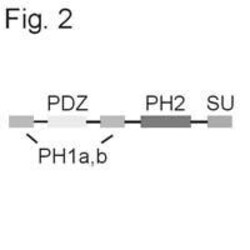
- Experimental details
- Protein schematic illustrates the common motif and domain organization found in the syntrophin isoforms.
 Explore
Explore Validate
Validate Learn
Learn Western blot
Western blot Immunoprecipitation
Immunoprecipitation